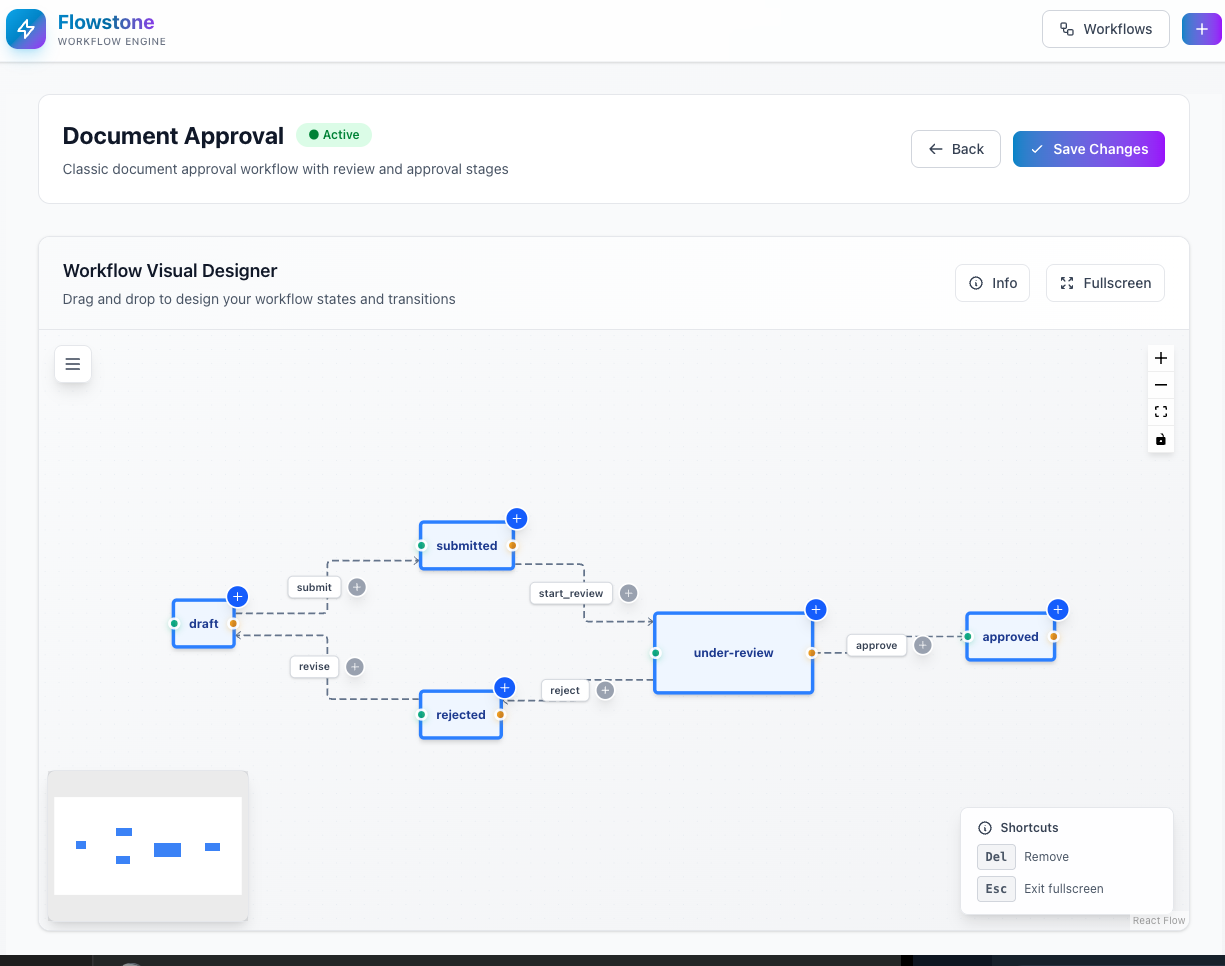cleaniquecoders / flowstone
Flowstone - Laravel Workflow Engine with Symfony Workflow Integration
Fund package maintenance!
Cleanique Coders
Installs: 256
Dependents: 0
Suggesters: 0
Security: 0
Stars: 2
Watchers: 0
Forks: 1
Open Issues: 1
pkg:composer/cleaniquecoders/flowstone
Requires
- php: ^8.2
- cleaniquecoders/laravel-action: ^2.2
- cleaniquecoders/traitify: ^1.2.1
- illuminate/contracts: ^10.0||^11.0||^12.0
- livewire/livewire: ^3.0
- spatie/laravel-package-tools: ^1.16
- symfony/workflow: ^6.4||^7.0
Requires (Dev)
- larastan/larastan: ^2.0||^3.0
- laravel/pint: ^1.14
- nunomaduro/collision: ^7.0||^8.0
- orchestra/testbench: ^8.0||^9.0||^10.0
- pestphp/pest: ^2.0||^3.0||^4.0
- pestphp/pest-plugin-arch: ^2.0||^3.0||^4.0
- pestphp/pest-plugin-laravel: ^2.0||^3.0||^4.0
- phpstan/extension-installer: ^1.4
- phpstan/phpstan-deprecation-rules: ^1.0||^2.0
- phpstan/phpstan-phpunit: ^1.0||^2.0
README
Flowstone is a powerful Laravel package that integrates the robust Symfony Workflow engine into your Laravel applications. Build sophisticated workflow and state machine systems with database-driven configurations, role-based permissions, and seamless Laravel integration.
🚀 Key Features
- 🔄 Database-Driven Workflows - Configure workflows through the database for runtime flexibility
- 🏛️ Symfony Workflow Integration - Built on the proven Symfony Workflow component
- 👥 Role-Based Permissions - Control who can perform transitions with metadata-driven roles
- 📊 Predefined Status Enum - Ready-to-use workflow states (Draft, Pending, Approved, etc.)
- ⚡ Performance Optimized - Workflow configuration caching and efficient queries
- 🎯 Multiple Workflow Types - Support for both State Machines and Workflows
💡 Why Flowstone?
Laravel-Native Workflow Integration
Unlike Symfony's configuration-based approach, Flowstone uses Laravel traits for better developer experience:
// ✅ Flowstone way - Full IDE support! class Document extends Model implements WorkflowContract { use InteractsWithWorkflow; // Get 50+ workflow methods instantly // IDE autocomplete ✅ | Type hints ✅ | Dynamic workflows ✅ } // ❌ Symfony way - Config-based, no IDE support 'supports' => [App\Models\Document::class], // Hard-coded in config
Benefits:
- ✅ Full IDE Autocomplete - IntelliSense for all workflow methods
- ✅ Type Safety - Compile-time type checking
- ✅ Dynamic Workflows - Choose workflows at runtime
- ✅ Self-Documenting - Just look at the model to see workflow support
- ✅ Better Testing - Mock workflow behavior directly
See detailed comparison in docs.
Table of Contents
Requirements
- PHP: 8.2, 8.3, or 8.4
- Laravel: 10.x, 11.x, or 12.x
- Database: MySQL, PostgreSQL, SQLite, or SQL Server
Version Compatibility
| Flowstone | PHP | Laravel | Symfony Workflow | Livewire |
|---|---|---|---|---|
| 1.3.1+ | 8.2-8.4 | 10.x-12.x | 6.4-7.x | 3.0+ |
| 1.3.0 | 8.4 | 11.x-12.x | 7.3+ | 3.6+ |
Note: Laravel 9 is not supported due to dependency requirements. Laravel 9 reached end-of-life in February 2024.
Installation
Install Flowstone via Composer:
composer require cleaniquecoders/flowstone
Publish and run the migrations:
php artisan vendor:publish --tag="flowstone-migrations"
php artisan migrate
Optionally, publish the configuration file:
php artisan vendor:publish --tag="flowstone-config"
Documentation
Comprehensive documentation is available in the docs/ directory:
- Getting Started - Installation and quick start guide
- Configuration - Configure workflows, UI, and performance
- Usage Guide - Workflows, details, and visual designer
- API Reference - Complete API documentation
Examples
Real-world examples are available in the examples/ directory:
- Bug Tracking - Issue lifecycle management
- Content Publishing - Content approval workflow
- Document Approval - Multi-step approval process
- E-commerce Order - Order fulfillment workflow
- Employee Onboarding - New hire process
Testing
composer test
Contributing
Please see CONTRIBUTING for details.
License
The MIT License (MIT). Please see License File for more information.

